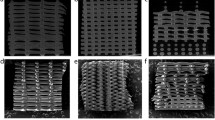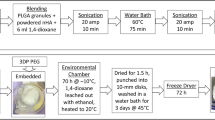Abstract
Tissue engineering is a promising technique for the repair of bone defects. An efficient and homogeneous distribution of cell seeding into scaffold is a crucial but challenging step in the technique. Murine bone marrow mesenchymal stem cells were seeded into porous hydroxyapatite scaffolds of two morphologies by three methods: static seeding, semi-dynamic seeding, or dynamic perfusion seeding. Seeding efficiency, survival, distribution, and proliferation were quantitatively evaluated. To investigate the performance of the three seeding methods for larger/thicker scaffolds as well as batch seeding of numerous scaffolds, three scaffolds were stacked to form assemblies, and seeding efficiencies and cell distribution were analyzed. The semi-dynamic seeding and static seeding methods produced significantly higher seeding efficiencies, vitalities, and proliferation than did the dynamic perfusion seeding. On the other hand, the semi-dynamic seeding and dynamic perfusion seeding methods resulted in more homogeneous cell distribution than did the static seeding. For stacked scaffold assemblies, the semi-dynamic seeding method also created superior seeding efficiency and longitudinal cell distribution homogeneity. The semi-dynamic seeding method combines the high seeding efficiency of static seeding and satisfactory distribution homogeneity of dynamic seeding while circumventing their disadvantages. It may contribute to improved outcomes of bone tissue engineering.





Similar content being viewed by others
Data Availability Statements
The datasets generated during and analyzed during the current study are available from the corresponding author on reasonable request.
Abbreviations
- HA:
-
Hydroxyapatite
- 3D:
-
Three-dimension
- MTT:
-
3-(4, 5-dimethylthiazol-2-yl)-2, 5-diphenyltetrazolium bromide
- LDH:
-
Lactate dehydrogenase
- MSCs:
-
Mesenchymal stem cells
References
Baba Ismail YM, Reinwald Y, Wimpenny I, Bretcanu O, Dalgarno K, El Haj AJ (2018) The Influence of Scaffold Designs on Cell Seeding Efficiency in Establishing A Three-Dimensional Culture Journal of Physics: Conference Series 1082:012072 doi:https://doi.org/10.1088/1742-6596/1082/1/012072
Bai H, Wang D, Delattre B, Gao W, De Coninck J, Li S, Tomsia AP (2015) Biomimetic gradient scaffold from ice-templating for self-seeding of cells with capillary effect. Acta Biomat 20:113–119. doi:https://doi.org/10.1016/j.actbio.2015.04.007
Cámara-Torres M, Sinha R, Mota C, Moroni L (2020) Improving cell distribution on 3D additive manufactured scaffolds through engineered seeding media density and viscosity. Acta Biomat 101:183–195. doi:https://doi.org/10.1016/j.actbio.2019.11.020
Chen GB, Xu R, Zhang C, Lv YG (2017) Responses of MSCs to 3D scaffold matrix mechanical properties under oscillatory perfusion. Culture Acs Appl Mater Interf 9:1207–1218. doi:https://doi.org/10.1021/acsami.6b10745
Choi WI, Yameen B, Vilos C, Sahu A, Jo S-M, Sung D, Tae G (2017) Optimization of fibrin gelation for enhanced cell seeding and proliferation in regenerative medicine applications Polymers. Adv Technol 28:124–129. doi:https://doi.org/10.1002/pat.3866
Costantini M et al (2016) Correlation between porous texture and cell seeding efficiency of gas foaming and microfluidic foaming scaffolds. Mater Sci Eng: C 62:668–677. doi:https://doi.org/10.1016/j.msec.2016.02.010
Ding C-M, Zhou Y, He Y-N, Tan W-S (2008) Perfusion seeding of collagen–chitosan sponges for dermal tissue engineering. Process Biochem 43:287–296. doi:https://doi.org/10.1016/j.procbio.2007.12.005
Ding M, Henriksen SS, Wendt D, Overgaard S (2015) An automated perfusion bioreactor for the streamlined production of engineered osteogenic grafts. J Biomed Mater Res Part B Appl Biomater 104:532–537. doi:https://doi.org/10.1002/jbm.b.33407
Dong J, Uemura T, Shirasaki Y, Tateishi T (2002) Promotion of bone formation using highly pure porous β-TCP combined with bone marrow-derived osteoprogenitor. Cells Biomater 23:4493–4502. doi:https://doi.org/10.1016/S0142-9612(02)00193-X
Du Y, Guo JL, Wang J, Mikos AG, Zhang S (2019) Hierarchically designed bone scaffolds: From internal cues to. External Stimuli Biomater 218:119334. doi:https://doi.org/10.1016/j.biomaterials.2019.119334
Filipowska J, Reilly GC, Osyczka AM (2016) A single short session of media perfusion induces osteogenesis in hBMSCs cultured in porous scaffolds. Dependent Cell Differ Stage Biotechnol Bioeng 113:1814–1824. doi:https://doi.org/10.1002/bit.25937
Florczyk SJ et al (2012) Enhanced bone tissue formation by alginate gel-assisted cell seeding in porous ceramic scaffolds and sustained release of growth factor. J Biomed Mater Res Part A 100A:3408–3415. doi:https://doi.org/10.1002/jbm.a.34288
Hong M-H, Kim S-M, Om J-Y, Kwon N, Lee Y-K (2014) Seeding cells on calcium phosphate scaffolds using hydrogel enhanced osteoblast proliferation and differentiation. Ann Biomed Eng 42:1424–1435. doi:https://doi.org/10.1007/s10439-013-0926-z
Hori A, Agata H, Takaoka M, Tojo A, Kagami H (2016) Effect of cell seeding conditions on the efficiency of vivo bone formation. Int J Oral Maxillofac Implants 31:232–239. doi:https://doi.org/10.11607/jomi.4729
Kitagawa T, Yamaoka T, Iwase R, Murakami A (2006) Three-dimensional cell seeding and growth in radial-flow perfusion bioreactor for in vitro tissue reconstruction. Biotechnol Bioeng 93:947–954. doi:https://doi.org/10.1002/bit.20797
Kleinhans C et al (2015) A perfusion bioreactor system efficiently generates cell-loaded bone substitute materials for addressing critical size bone defects. Biotechnol J 10:1727–1738. doi:https://doi.org/10.1002/biot.201400813
Lemonnier S et al (2014) Dynamic mesenchymal stem cells volumic seeding in a commercialized porous ceramic scaffold: a feasibility study. Comput Methods Biomech BioMed Eng 17:4–5. doi:https://doi.org/10.1080/10255842.2014.931049
Li J et al (2016a) Ectopic osteogenesis and angiogenesis regulated by porous architecture of hydroxyapatite scaffolds with similar interconnecting structure in vivo. Regen Biomater 3:285–297. doi:https://doi.org/10.1093/rb/rbw031
Li Y, Wang J, Xing J, Wang Y, Luo Y (2016b) Surface chemistry regulates the sensitivity and tolerability of osteoblasts to various magnitudes of fluid shear stress. J Biomed Mater Res Part A 104:2978–2991. doi:https://doi.org/10.1002/jbm.a.35848
Lv XG et al (2016) Comparative study of different seeding methods based on a multilayer SIS scaffold: Which is the optimal procedure for urethral tissue engineering? J Biomed Mater Res Part B: Appl Biomater 104:1098–1108. doi:https://doi.org/10.1002/jbm.b.33460
McBeath R, Pirone DM, Nelson CM, Bhadriraju K, Chen CS (2004) Cell shape, cytoskeletal tension, and RhoA regulate stem cell lineage commitment. Developmental cell 6:483–495. doi:https://doi.org/10.1016/s1534-5807(04)00075-9
Melchels FPW, Barradas AMC, van Blitterswijk CA, de Boer J, Feijen J, Grijpma DW (2010) Effects of the architecture of tissue engineering scaffolds on cell seeding and culturing. Acta Biomater 6:4208–4217. doi:https://doi.org/10.1016/j.actbio.2010.06.012
Melchels FPW et al (2011) The influence of the scaffold design on the distribution of adhering cells after perfusion cell seeding. Biomaterials 32:2878–2884. doi:https://doi.org/10.1016/j.biomaterials.2011.01.023
Melchiorri AJ, Bracaglia LG, Kimerer LK, Hibino N, Fisher JP (2016) In vitro endothelialization of biodegradable vascular grafts via endothelial progenitor cell seeding and maturation in a tubular perfusion system bioreactor tissue engineering Part C. Methods 22:663–670. doi:https://doi.org/10.1089/ten.tec.2015.0562
Olivares AL, Lacroix D (2012) Simulation of cell seeding within a three-dimensional porous scaffold: a fluid-particle analysis tissue engineering part. C-Methods 18:624–631. doi:https://doi.org/10.1089/ten.tec.2011.0660
Reinwald Y, Johal RK, Ghaemmaghami AM, Rose FRAJ, Howdle SM, Shakesheff KM (2014) Interconnectivity and permeability of supercritical fluid-foamed scaffolds and the effect of their structural properties on cell distribution. Polymer 55:435–444. doi:https://doi.org/10.1016/j.polymer.2013.09.041
Salita S, Amornsudthiwat P, Damrongsakkul S, Kanokpanont S (2016) An axial distribution of seeding, proliferation, and osteogenic differentiation of MC3T3-E1 cells and rat bone marrow-derived mesenchymal stem cells across a 3D Thai silk fibroin/gelatin/hydroxyapatite scaffold in a perfusion bioreactor. Mater Sci Eng: C: C 58:960–970. doi:https://doi.org/10.1016/j.msec.2015.09.034
Shi F, Zhi W, Liu Y, Zhou T, Weng J (2017) One-step method to construct hydroxyapatite scaffolds with 3-D interconnected structure by a novel hydrogel bead porogen process. Mater Lett 203:13–16. doi:https://doi.org/10.1016/j.matlet.2017.05.099
Soleimani M, Nadri S (2009) A protocol for isolation and culture of mesenchymal stem cells from mouse bone marrow. Nat Protoc 4:102–106. doi:https://doi.org/10.1038/nprot.2008.221
Su W-T, Wang Y-T, Chou C-M (2014) Optimal fluid flow enhanced mineralization of MG-63 cells in porous chitosan scaffold. J Taiwan Inst Chem Eng 45:1111–1118. doi:https://doi.org/10.1016/j.jtice.2013.10.016
Theodoridis K et al (2020) An effective device and method for enhanced cell growth in 3D scaffolds: Investigation of cell seeding and proliferation under static and dynamic conditions. Mater Sci Eng: C 114:111060. doi:https://doi.org/10.1016/j.msec.2020.111060
Tuin SA, Pourdeyhimi B, Loboa EG (2016) Fabrication of novel high surface area mushroom gilled fibers and their effects on human adipose derived stem cells under pulsatile fluid flow for tissue engineering applications. Acta Biomater 36:220–230. doi:https://doi.org/10.1016/j.actbio.2016.03.025
Vila OF et al (2016) Real-time bioluminescence imaging of cell distribution, growth, and differentiation in a three-dimensional scaffold under interstitial perfusion for tissue engineering tissue engineering part C. Methods 22:864–872. doi:https://doi.org/10.1089/ten.tec.2014.0421
Vitacolonna M, Belharazem D, Hohenberger P, Roessner ED (2013) Effect of static seeding methods on the distribution of fibroblasts within human acellular dermis. Biomed Eng Online 12:55. doi:https://doi.org/10.1186/1475-925X-12-55
Vitacolonna M, Belharazem D, Hohenberger P, Roessner ED (2015) Effect of dynamic seeding methods on the distribution of fibroblasts within human acellular dermis. Cell Tissue Banking 16:605–614. doi:https://doi.org/10.1007/s10561-015-9508-7
Wang L et al (2014) Repair of segmental bone defect using totally vitalized tissue engineered bone graft by a combined perfusion seeding and culture. System Plos One 9:e94276. doi:https://doi.org/10.1371/journal.pone.0094276
Wu YF, Chen C, Tang JB, Mao WF (2020) Growth and stem cell characteristics of tendon-derived cells with different initial seeding densities: an in vitro study in mouse flexor tendon cells. Stem Cells Dev 29:1016–1025. doi:https://doi.org/10.1089/scd.2020.0036
Yamanaka K et al (2015) Seeding of mesenchymal stem cells into inner part of interconnected porous biodegradable scaffold by a new method with a filter paper. Dent Mater J 34:78–85. doi:https://doi.org/10.4012/dmj.2013-330
Yang Y et al (2016) Melatonin reverses flow shear stress-induced injury in bone marrow mesenchymal stem cells via activation of AMP-activated protein kinase signaling. J Pineal Res 60:228–241. doi:https://doi.org/10.1111/jpi.12306
Zhang Z-Z, Jiang D, Wang S-J, Qi Y-S, Zhang J-Y, Yu J-K (2015) Potential of centrifugal seeding method in improving cells distribution and proliferation on demineralized cancellous bone scaffolds for tissue-engineered meniscus. ACS Appl Mater Interfaces 7:15294–15302. doi:https://doi.org/10.1021/acsami.5b03129
Zhao F, Ma T (2005) Perfusion bioreactor system for human mesenchymal stem cell tissue engineering: dynamic cell seeding and construct development. Biotechnol Bioeng 91:482–493. doi:https://doi.org/10.1002/bit.20532
Zhao J, Lu X, Duan K, Guo L, Zhou S, Weng J (2009) Improving mechanical and biological properties of macroporous HA scaffolds through composite coatings. Colloids Surf B 74:159–166. doi:https://doi.org/10.1016/j.colsurfb.2009.07.012
Acknowledgements
This research was funded by National Natural Science Foundation of China (2016YFB0700803), Sichuan Science and Technology Program (2020065, 21MZGC0218), Major Project of Education Department in Sichuan Province (18CZ0019), Startup Program of Southwest Normal University (18Q069, 18Q030), Luzhou-SWMU Strategic Cooperation Program (2017LZXNYD-J35).
Funding
No competing financial interests exist.
Author information
Authors and Affiliations
Corresponding authors
Ethics declarations
Conflict of interest
The authors declare no conflict of interest.
Additional information
Publisher’s Note
Springer Nature remains neutral with regard to jurisdictional claims in published maps and institutional affiliations.
Rights and permissions
About this article
Cite this article
Shi, F., Duan, K., Yang, Z. et al. Improved cell seeding efficiency and cell distribution in porous hydroxyapatite scaffolds by semi-dynamic method. Cell Tissue Bank 23, 313–324 (2022). https://doi.org/10.1007/s10561-021-09945-5
Received:
Accepted:
Published:
Issue Date:
DOI: https://doi.org/10.1007/s10561-021-09945-5




